Assessment of Potential Health Benefits of Noise Abatement Measures in the European Union: Phenomena—A Study for the European Commission
By Michael Dittrich, Erik Salomons, Eszter Kantor, Magdalena Klebba, Nico van Oosten, Itziar Aspuru, Nuria Blanes, and Jaume Fons
Introduction
In March 2021, a study was concluded on the Potential Health Benefits of Noise Abatement Measures in the European Union (Phenomena),1 performed for the European Commission Directorate-General for Environment by a consortium consisting of VVA, TNO, Anotec Engineering, Tecnalia, and Autonomous University of Barcelona.
Noise exposure from road, rail, and aircraft is a major health burden, second only to air pollution, with around one in five people in the EU exposed to high noise levels with negative impacts on health. Road traffic has by far the largest impact. According to the World Health Organization (WHO), the impacts include cardiovascular disease, cognitive impairment in children, sleep disturbance, and annoyance.2 With traffic and urbanization continuously growing, policies are required to reduce these impacts. In the EU policy framework, there are several instruments for this, such as the Environmental Noise Directive (END), legislation for noise limits for new road and railway vehicles, operational regulations for Aircraft (Balanced Approach, and for railways (quieter routes), and the Green Deal, which includes noise as well as emissions.3–8
The objective of the study was to support the European Commission in defining noise abatement measures capable of delivering a 20–50 percent reduction of the health burden due to environmental noise from roads, railways, and aircraft and to assess how relevant noise-related legislation could enhance the implementation of measures, while considering the constraints and specificities of each transport mode. The project collected and analyzed data from geographic areas as set by the END, for
- roads and railways inside agglomerations of more than 100,000 inhabitants;
- major roads with more than 3 million vehicles a year;
- major railway lines with more than 30,000 trains a year; and
- major airports with more than 50,000 movements a year.
The focus was on situations with long-term noise exposure levels above 53 dB Lden for roads, above 54 dB Lden for railways, and above 45 dB Lden for airports. These are the exposure levels mentioned by WHO’s 2018 Environmental Noise Guidelines for the European Region.9
Peak noise from occasional sources that does not affect the Lden levels was not within the scope, although it can be relevant for perceived noise. Health impacts are primarily associated with the year-averaged Lden and Lnight levels.
The study ensured that results are representative at the EU level by analyzing a wide range of literature sources and assessing a balanced selection of member state noise abatement practices. The following was undertaken to achieve these objectives:
- A review of international and EU literature as well as EU and member state legislation
- Assessment of noise action plans (NAPs) and their implementation and enforcement
- A broad stakeholder consultation and two stakeholder workshops
- Identification and assessment of legislative drivers of noise abatement solutions
- Revision of the intervention logic
- Listing of good practices
- Health impact assessment and cost-benefit analysis (CBA)
- Assessment of available noise abatement solutions
- Scenario analysis of noise abatement solutions
- Proposals for EU and member state policies to reduce the health burden
Overall Findings
Overall, the study found that within the given time frame up to 2030, more than 20 percent reduction in health burden would be feasible, and this is possible only by using combined noise abatement solutions, which are driven and supported by revised and strengthened EU environmental policies, including the END, noise source directives (limits for vehicle noise emission), the European Green Deal, and other legislative measures with a strong environmental impact. There is also a recognition that a revised EU policy framework is only as good as the national implementation and enforcement measures are in the member states. Consequently, in order to harmonize the fragmented approaches currently seen in member states and to drive the dissemination of good practices, increased emphasis should be put on the consultative participation of those national and local authorities that identify, select, and implement noise abatement measures.
EU and National Legislation
Overall, the study found that within the given time frame up to 2030, more than 20 percent reduction in health burden would be feasible, and this is possible only by using combined noise abatement solutions, which are driven and supported by revised and strengthened EU environmental policies, including the END, noise source directives (limits for vehicle noise emission), the European Green Deal, and other legislative measures with a strong environmental impact. There is also a recognition that a revised EU policy framework is only as good as the national implementation and enforcement measures are in the member states. Consequently, in order to harmonize the fragmented approaches currently seen in member states and to drive the dissemination of good practices, increased emphasis should be put on the consultative participation of those national and local authorities that identify, select, and implement noise abatement measures.
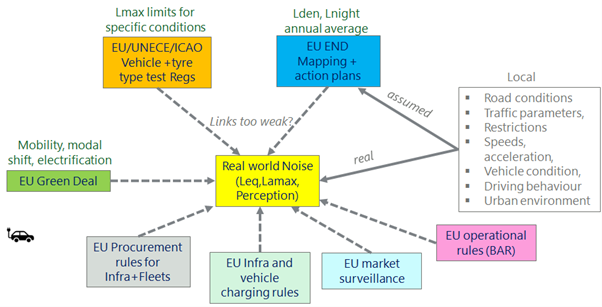
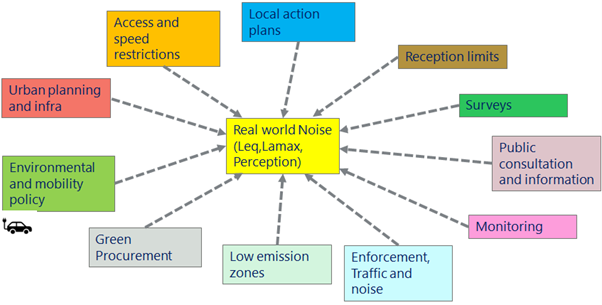
Noise Action Plans
Three hundred NAPs were reviewed with the aim of identifying which noise abatement measures have been planned and implemented in member states. For 100 action plans, more detailed information was gathered on the implemented interventions and the extent to which national and EU legislations drive the implementation of noise abatement measures.
Road: Member states may prefer noise barriers, quiet road surfaces, and road maintenance as main solutions. These are usually combined with other source and infrastructure interventions and mobility plans depending on the availability of financial and technical resources. Public awareness and information campaigns are less common.
Rail: Common measures implemented or planned are rail grinding, noise barriers, rail dampers, and embankments. Also innovative or unique solutions such as quieter railpads or low barriers were identified, although these are not widespread and not yet approved everywhere.
Aviation: Measures are both at receiver and source level. These often combine operating restrictions such as curfews with a penalty regime, noise monitoring, and infrastructure development, including lengthening the runway to avoid low flights over residential areas.
Stakeholder Consultation and Workshops
Stakeholders were widely consulted throughout the project. Bilateral interviews with member state officials, private enterprises, NGOs, associations, researchers, and EU officials were conducted. The purpose of the interviews was to gather information relating to national or EU level implementation of noise abatement solutions and to clarify stakeholders’ positions on the effectiveness of noise abatement measures as well as their suggestions on potential improvements. Altogether 64 stakeholder interviews were carried out, bringing together a balanced set of opinions from the three transport modes and agglomeration representatives of various member states.
Also two online workshops were held in June and November 2020, attracting over 200 participants from across Europe.
Intervention Logic
Intervention logic is the causal relationship between the needs, objectives, and inputs that drives the action of intervention and results in a form of desired outputs, results, and impacts. A revised intervention logic was proposed, with more defined needs and objectives for reducing noise pollution and relating it to the health burden. These needs and objectives can be met by a more effective implementation of a common approach to noise reduction, which also takes socioeconomic characteristics into account, for example, population growth and increased urbanization, share of low-income households, increasing connectivity in densely populated urban areas, and transport innovation. The revised intervention logic emphasizes those supporting measures that can further increase the application of relevant regulatory frameworks, such as financial assistance or stakeholder involvement.
The revised intervention logic emphasizes a more effective implementation that relies on a combination of measures including compliance with relevant EU and national policies as well as innovation and collaboration. Coherence between EU and member state policies, including those on thresholds and noise emission limits, is essential for achieving cohesion between noise abatement measures in the member states. Moreover, increased coherence between noise policy and various other policy areas to enhance cobenefits (e.g., urban and mobility plans) should be explored to facilitate a more effective implementation of noise abatement measures.
Methodology for Analysis
A methodology was set up to quantify the health burden and its reduction at EU level over time. The driving forces, pressures, state, exposures, health effects and actions (DPSEEA) framework (fig. 3) was applied, quantifying each step in the chain from source to receiver and health impact (fig. 4). The health burden is quantified not only by two monetization methods to account for potential spread but also in terms of percentage reduction of highly annoyed people, highly sleep-disturbed people, and disability-adjusted life years (DALYs, including heart disease. The present average noise distribution in the EU, from EEA data, is used for the baseline, and forecast traffic growth (around 1 percent per annum) and currently foreseen noise legislation is taken into account.
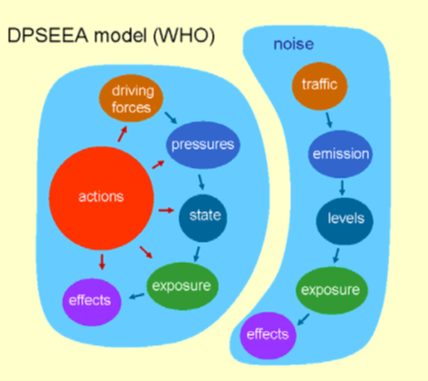
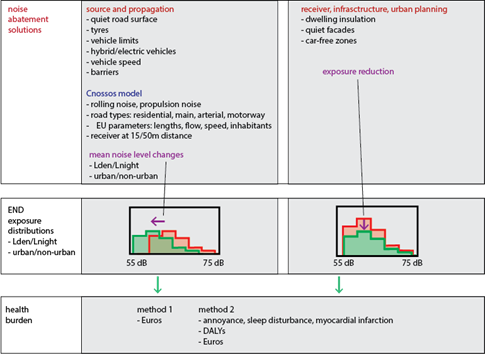
The health burden reduction is calculated from the change in the noise distribution resulting from deviations from the baseline, for example, due to further reduction of noise at source, in the propagation path, or at the receiver.
The CBA is based on the costs for increased implementation of noise abatement measures and the monetized health benefits using the two methods. It results in a benefit-to cost ratio over the period 2020–2035, net present value, and a breakeven year (see example in fig. 5).
Test Site Analysis
The methodology for calculating noise exposure in the EU was based on the exposure distributions calculated in the framework of the END. So as to indicate the uncertainty of the distributions, the END results were compared with the results of local noise mapping calculations for test sites. The following types of test sites were considered:
- Subareas of urban agglomerations with road and rail traffic noise
- Areas near major roads and major railways
- Airports and surrounding area
The test site calculations focused on the effects of noise abatement solutions on the noise exposure distributions. This provided input for the effects of noise abatement solutions in the global health impact assessment methodology. Two examples are the following.
- Noise barrier. The effect of inserting a noise barrier in a specific situation has been investigated for various road and railway test sites.
- Rerouting traffic. A complex noise abatement solution is rerouting of urban traffic. This has been investigated by a test site calculation for the city of Karlsruhe (DE).
It appeared from the test site calculations that the effect of (local) traffic measures such as rerouting on the exposure distributions of the entire city is usually quite small, partly because the noise is shifted from one area to another. Furthermore, it was found that low-speed urban streets (50 km/h, 30 km/h) have a major effect on the exposure distributions.
Noise Abatement Solutions
For each transport mode, available noise abatement solutions were selected for this analysis in terms of their potential noise reduction and known effectiveness. Innovations and solutions still under development were not included, as they would not be widely available by 2030.
For road transport, the solutions considered include (a) quieter road surfaces, (b) quieter tires, (c) quieter vehicles, (d) more electric vehicles, (e) noise barriers, (f) speed restriction, (g) car-free zones, (h) quiet facades, (i) dwelling insulation, and (j) reception limits.
The railway noise abatement solutions include (a) smooth tracks, (b) smooth wheels, (c) quiet vehicles, (d) quiet tracks, (e) barriers, (f) traffic management, (g) urban planning, (h) dwelling insulation, and (i) reception limits. For aircraft, the main noise abatement solutions include (a) improved flight profiles, (b) precision area navigation, (c) night curfews, (d) phaseout of noisier aircraft, (e) accelerated fleet renewal, (f) sound insulation, (g) buffer zones, (h) stakeholder engagement, and (i) reception limits.
Scenario Analysis
Single and combined scenarios were analyzed in terms of their reduction in health burden and benefit-to-cost ratio (BCR). The results for road scenarios are shown in figure 5. Combined scenarios are mostly required to achieve a significant effect by 2030. The selection was based on the health burden reduction, feasibility, and timescale. In some cases, the health burden reduction is high but the BCR rather low, due to relatively high cost, for example, in the case of urban planning. This should not necessarily disqualify these solutions, as the benefits may actually be much larger if more parameters than noise are factored in, for example, reduced pollution, improved access and property value, quality of life, and others. Where the reductions seem moderate, such as for vehicle noise limits, it should be considered that foreseen limit changes as in regulation 540/2014/EU are already included in the baseline. The limited effect of more electric vehicles is due to the tire noise contribution, if tires are not quieter. The quiet road surfaces scenario is counterintuitive, as it can give a large noise reduction for speeds above 50 km/h. This is because the implementation at EU level is low and urban roads with lower speeds have a much larger overall length. Further variations on these results and results for railway and aircraft noise are presented in the report.11
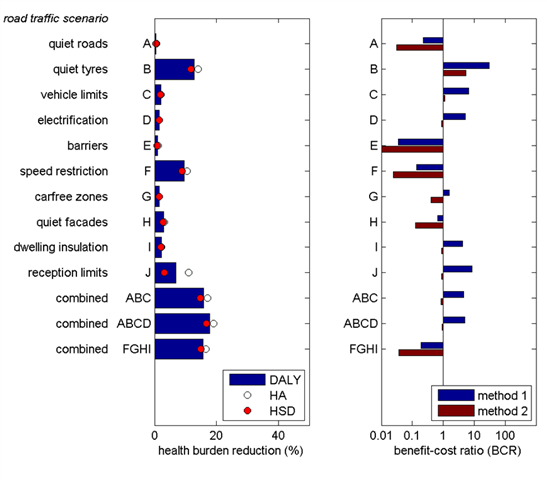
The most effective scenarios identified and their reductions in monetized health burden and BCRs are set out in table 1 for all three modes of transport.

Policy Options
Policy options were developed based on the results of the NAPs analysis, stakeholder consultations, and the CBA and noise abatement scenarios set out earlier. The analysis found that an effective and EU-wide reduction of noise emission, which would result in a decrease of at least 20 percent of associated health burden within the next 10 years, cannot be reached by individual scenarios but rather by a set of combined and complementary abatement measures. The highest benefits from noise reduction are to be expected from the implementation of the most cost-effective combined scenarios.
The proposed measures that could be implemented within the next 10 years include both mandatory (hard) and optional (soft) policies. In addition to noise- and transport-specific instruments such as the END, vehicle and tire sound limits regulations, TSI Noise limits for rail vehicles, and the Balanced Approach Regulation (BAR) for aircraft, other instruments not related to noise policy (legislative and nonlegislative across various policy areas) have also been analyzed. Altogether 23 individual policy changes are proposed. This includes 6 legislative changes for generic policy measures and 17 specific for road, rail, and aviation. Most of the proposals require review and amendment of EU Directives or Regulations.
This approach follows the principle of horizontally integrating environmental issues into different policy areas. Therefore, it is suggested that the proposed policy options are developed within the context of an overarching strategy. This will require setting an overall target of the noise reduction across different policy fields. This strategy could be ideally composed of a set of a horizontal (general) and vertical (sector-specific) measures. The establishment of such an umbrella approach would streamline the efforts undertaken and ensure their timely application.
The recommended generic policy options include the following:
- Standardization, streamlining, and mandatory evaluation of NAPs
- Extend the scope of the END to urban planning, infrastructure planning, and land use
- Introduction of EU noise reception limits at dwellings
- Improve coherence between noise prediction models and vehicle type tests
- Include noise requirements in public procurement procedures for vehicles and transport infrastructure
- Enhance EU financial incentives and increase noise charges
The proposed policy options for road, rail, and aircraft are shown graphically in figures 6, 7, and 8, as recommended actions for existing regulations. The options that can be addressed at EU level are marked in red.
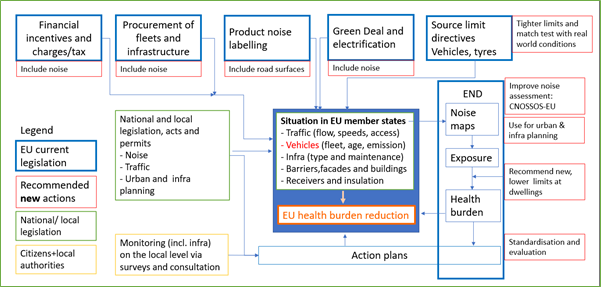
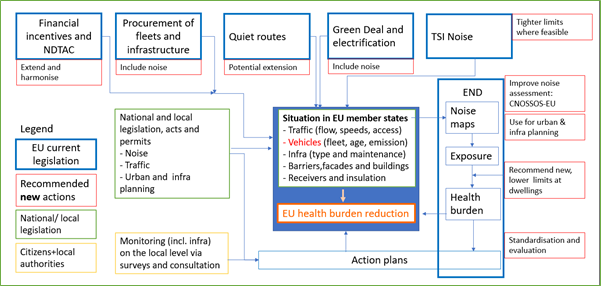
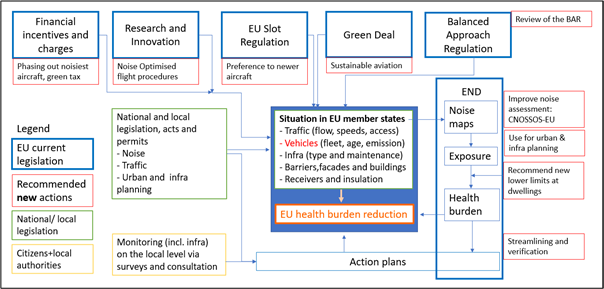
Conclusions
The Phenomena study has provided a series of policy recommendations to reduce the health burden of environmental noise from roads, railways, and aviation by 20–50 percent by 2030. These recommendations would require updating of existing EU noise legislation and better integration for coherence and effectiveness. In particular the follow-up of action plan implementation and the application of combined noise abatement measures needs strengthening. These are administered and implemented at national and local levels, so better management, resourcing, guidelines, and information exchange are required.
Acknowledgments and Disclaimer
The Phenomena study was funded by the European Commission Directorate-General for Environment, whose support is gratefully acknowledged. Thanks are also due to the many stakeholders who provided inputs during the study. The work was performed under EU Contract number 07.0203/2019/ETU/815591/ENV.A.3. The contents of the report and this article represent the findings and conclusions of the authors and do not represent the position of the EU.
Notes
Michael Dittrich, Erik Salomons: TNO, The Netherlands; Eszter Kantor, Magdalena Klebba: VVA, Belgium; Nico van Oosten: Anotec Engineering, Spain; Itziar Aspuru: Tecnalia, Spain; Nuria Blanes, Jaume Fons: Autonomous University of Barcelona, Spain.
1. VVA, TNO, Anotec, Tecnalia, and UAB, Phenomena Study: Final Report, March 2021, https://op.europa.eu/en/publication-detail/-/publication/f4cd7465-a95d-11eb-9585-01aa75ed71a1/language-mt.
2. Environmental Noise Guidelines for the European Region, World Health Organization, 2018.
3. Environmental noise directive (END) 2002/49/EC.
4. EU regulation on vehicle sound limits 540/2014/EU.
5. TSI Noise, EU regulation on sound limits for railway vehicles.
6. EU balanced approach regulation on aircraft operations 598/2014.
7. European Green Deal, https://ec.europa.eu/info/strategy/priorities-2019-2024/european-green-deal_en.
8. Railway vehicle noise limits in TSI 1304/2014/EU and quieter routes regulation.
9. Noise in Europe, European Environment Agency, 2020.


